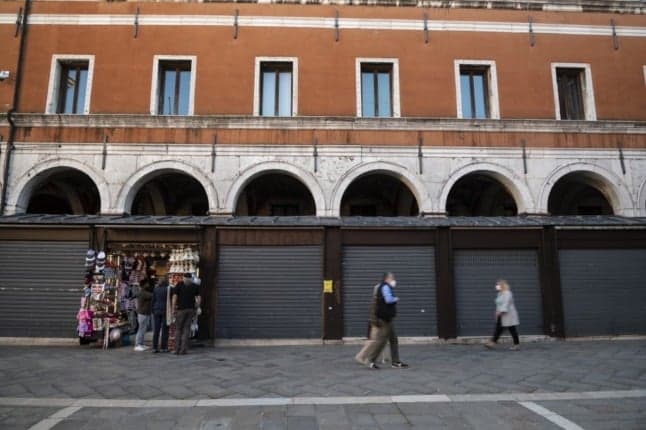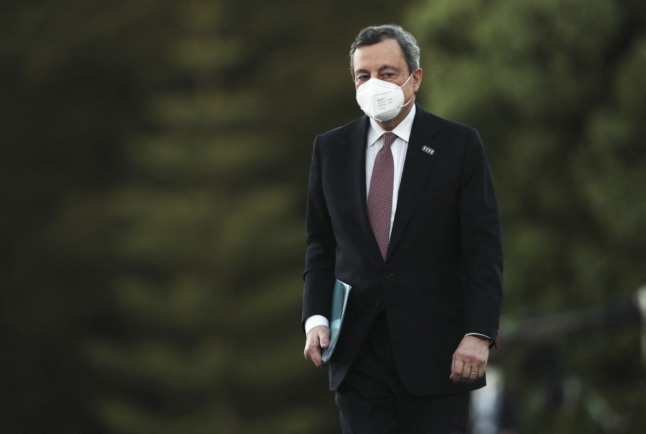Recovery fund: Italy faces 'formidable' post-Covid challenge, says central bank

Italy faces a "formidable challenge" as it tries to fix its long-ailing economy with the help of EU post-pandemic recovery funds, Italian central bank governor Ignazio Visco warned on Monday.
The eurozone's third-largest economy is due to receive loans and grants worth 191.5 billion euros ($233.5 billion) between 2021 and 2026, and its government has pledged a raft of reforms to put them to good use in its recovery plan ('piano nazionale di ripresa e resilienza' or PNRR).
The support measures put in place include funds for renovating energy-inefficient buildings and plans to upgrade public transport and wifi connections, as Italy's government says it aims to use the money to upgrade infrastructure and make Italy a "country for young people".
READ ALSO: Fast trains and extended building bonus: How Italy’s EU recovery plan could affect you
The EU-funded national recovery plan "must be part of a collective effort, aimed at overcoming Italy's structural weaknesses and the specific factors of the anaemic economic growth of the last two decades," Visco said.
"The opportunities Italy will be able to offer future generations depend on the success of the reforms and measures of the National Recovery and Resilience Plan," the governor stressed.
"It is a formidable challenge."
Visco, delivering his annual speech on the state of the economy, also warned that Italy could not afford to maintain the economic support measures introduced to soften the impact of the current recession.
READ ALSO:
- Under 36? Here’s how Italy plans to help you buy a house
- How you could win up to €5 million in Italy’s ‘receipt lottery’
- The building bonuses you could claim in Italy in 2021
"A future built on public subsidies and incentives is unthinkable," he said, noting that public debt, standing at around 160 percent of gross domestic product (GDP), has reached the highest level since the end of World War I.
However, "the support measures for households and firms must be withdrawn gradually and only when the economic situation has been sufficiently consolidated and uncertainty significantly reduced," the governor said.

Italy's Prime Minister Mario Draghi, former head of the European Central Bank, is managing the country's economic recovery plan. Photo: Luis Vieira/POOL/AFP
Italy was the first country in Europe to be hit by the coronavirus pandemic, triggering the worst slump in its postwar era.
The economy contracted by 8.9 percent last year and a million jobs have been lost, with many more expected if the country's current ban on redundancies is not extended next month.
Visco said that as the country continues to make progress with vaccinations and reopenings of the economy, he expected an accelerated recovery, with GDP expanding by more than four percent in 2021.
His expectations are broadly in line with government forecasts of annual GDP growth of 4.5 percent this year and 4.8 per cent in 2022, although Prime Minister Mario Draghi said earlier this month that they could be revised upwards.
After months of lockdown gloom, delays in vaccinations and a persistently high number of virus fatalities, things have started to look up in Italy, just in time for the onset of the summer season.
READ ALSO: Italy’s coronavirus infection rate falls to lowest level since October
On Sunday, the country recorded 44 Covid-19 deaths, the lowest daily tally in more than seven months, while the government said 20 percent of the population had been fully vaccinated.
Meanwhile, coronavirus curfews were lifted from Monday in three regions with low infection figures, including tourist favourite Sardinia.
It's hoped that the same easing of measures could be extended across most of the country in coming weeks.
Comments
See Also
The eurozone's third-largest economy is due to receive loans and grants worth 191.5 billion euros ($233.5 billion) between 2021 and 2026, and its government has pledged a raft of reforms to put them to good use in its recovery plan ('piano nazionale di ripresa e resilienza' or PNRR).
The support measures put in place include funds for renovating energy-inefficient buildings and plans to upgrade public transport and wifi connections, as Italy's government says it aims to use the money to upgrade infrastructure and make Italy a "country for young people".
READ ALSO: Fast trains and extended building bonus: How Italy’s EU recovery plan could affect you
The EU-funded national recovery plan "must be part of a collective effort, aimed at overcoming Italy's structural weaknesses and the specific factors of the anaemic economic growth of the last two decades," Visco said.
"The opportunities Italy will be able to offer future generations depend on the success of the reforms and measures of the National Recovery and Resilience Plan," the governor stressed.
"It is a formidable challenge."
Visco, delivering his annual speech on the state of the economy, also warned that Italy could not afford to maintain the economic support measures introduced to soften the impact of the current recession.
READ ALSO:
- Under 36? Here’s how Italy plans to help you buy a house
- How you could win up to €5 million in Italy’s ‘receipt lottery’
- The building bonuses you could claim in Italy in 2021
"A future built on public subsidies and incentives is unthinkable," he said, noting that public debt, standing at around 160 percent of gross domestic product (GDP), has reached the highest level since the end of World War I.
However, "the support measures for households and firms must be withdrawn gradually and only when the economic situation has been sufficiently consolidated and uncertainty significantly reduced," the governor said.

Italy was the first country in Europe to be hit by the coronavirus pandemic, triggering the worst slump in its postwar era.
The economy contracted by 8.9 percent last year and a million jobs have been lost, with many more expected if the country's current ban on redundancies is not extended next month.
Visco said that as the country continues to make progress with vaccinations and reopenings of the economy, he expected an accelerated recovery, with GDP expanding by more than four percent in 2021.
His expectations are broadly in line with government forecasts of annual GDP growth of 4.5 percent this year and 4.8 per cent in 2022, although Prime Minister Mario Draghi said earlier this month that they could be revised upwards.
After months of lockdown gloom, delays in vaccinations and a persistently high number of virus fatalities, things have started to look up in Italy, just in time for the onset of the summer season.
READ ALSO: Italy’s coronavirus infection rate falls to lowest level since October
On Sunday, the country recorded 44 Covid-19 deaths, the lowest daily tally in more than seven months, while the government said 20 percent of the population had been fully vaccinated.
Meanwhile, coronavirus curfews were lifted from Monday in three regions with low infection figures, including tourist favourite Sardinia.
It's hoped that the same easing of measures could be extended across most of the country in coming weeks.
Join the conversation in our comments section below. Share your own views and experience and if you have a question or suggestion for our journalists then email us at [email protected].
Please keep comments civil, constructive and on topic – and make sure to read our terms of use before getting involved.
Please log in here to leave a comment.